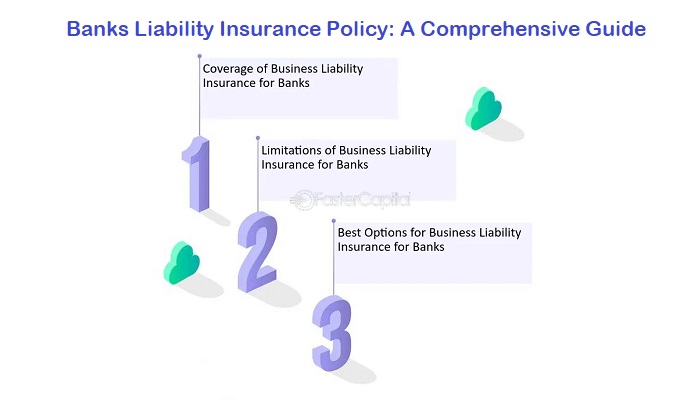
Banks Liability Insurance Policy: A Comprehensive Guide Leave a comment
Introduction: In the world of finance, risk management is paramount, particularly for banks that deal with vast sums of money and sensitive financial transactions. One essential aspect of risk management for banks is liability insurance. This article delves into the intricacies of bank liability insurance, exploring its significance, coverage, regulatory framework, and emerging trends.
Understanding Bank Liability Insurance Bank liability insurance, also known as financial institution bond insurance or bankers blanket bond insurance, is a specialized form of insurance designed to protect banks from financial losses resulting from fraudulent activities, employee dishonesty, theft, forgery, and other types of risks inherent in the banking industry.
Significance of Bank Liability Insurance For banks, maintaining trust and credibility is crucial for sustaining their operations and attracting customers. However, the nature of banking exposes institutions to various risks, including internal fraud, external theft, and cyberattacks.

Bank liability insurance serves as a vital risk mitigation tool, providing financial protection against losses arising from such risks. By safeguarding the bank’s assets and liabilities, this insurance instills confidence among stakeholders, including depositors, investors, and regulatory authorities.
Coverage Bank liability insurance typically offers comprehensive coverage tailored to the unique risks faced by financial institutions. The coverage may include:
Employee Dishonesty:
Protects against losses resulting from dishonest acts committed by employees, such as embezzlement, theft, or fraudulent activities.
Forgery or Alteration:
Covers losses arising from the forgery or alteration of negotiable instruments, checks, drafts, or other financial documents.
Computer Fraud:
Safeguards against losses caused by unauthorized access to the bank’s computer systems or fraudulent electronic transactions.
Funds Transfer Fraud:
Provides coverage for losses resulting from fraudulent instructions or unauthorized transfers of funds.
Counterfeit Currency:
Protects against losses incurred due to the acceptance of counterfeit currency or counterfeit financial instruments.
Securities Fraud:
Covers losses resulting from fraudulent activities related to the bank’s securities, investments, or trading activities.
Extortion:
Offers protection against losses resulting from threats of extortion or ransom demands.
Regulatory Framework The regulation of bank liability insurance varies across jurisdictions, with regulatory authorities imposing certain requirements to ensure adequate protection for depositors and the stability of the financial system. In the United States, for example, the Federal Deposit Insurance Corporation (FDIC) regulates bank insurance activities and mandates that insured banks maintain adequate insurance coverage to protect against potential losses.
Emerging Trends As the banking landscape evolves and new risks emerge, the demand for innovative insurance solutions continues to grow. Some emerging trends in bank liability insurance include:
Cyber Insurance:
With the increasing prevalence of cyber threats and data breaches, banks are increasingly investing in cyber insurance to protect against losses resulting from cyberattacks, data theft, and privacy breaches.
Regulatory Compliance Insurance:
Given the complex regulatory environment facing banks, there is a rising demand for insurance products that specifically address regulatory compliance risks, including fines, penalties, and legal expenses associated with regulatory violations.
Reputation Risk Insurance:
In an era of heightened public scrutiny and social media influence, banks are recognizing the importance of protecting their reputation. Reputation risk insurance provides coverage for losses stemming from damage to the bank’s reputation due to negative publicity, scandals, or public relations crises.
Climate Risk Insurance:
As climate change poses new challenges and uncertainties for banks, there is growing interest in climate risk insurance to mitigate the financial impact of extreme weather events, natural disasters, and other climate-related risks on bank operations and assets.
Conclusion:
Bank liability insurance plays a critical role in safeguarding the financial interests of banks and mitigating the risks inherent in the banking industry. By providing comprehensive coverage against fraud, theft, cyber risks, and other threats, this insurance helps banks maintain trust and confidence among stakeholders while ensuring regulatory compliance and financial stability.
As the banking landscape continues to evolve, the demand for innovative insurance solutions tailored to emerging risks will likely increase, highlighting the importance of proactive risk management and insurance planning for financial institutions.
